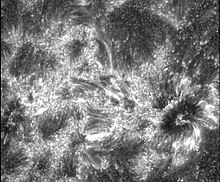First light (astronomy)
In astronomy, first light is the first use of a telescope (or, in general, a new instrument) to take an astronomical image after it has been constructed. This is often not the first viewing using the telescope; optical tests will probably have been performed to adjust the components.
Characteristics
[edit]The first light image is normally of little scientific interest and is of poor quality, since the various telescope elements are yet to be adjusted for optimum efficiency. Despite this, a first light is always a moment of great excitement, both for the people who design and build the telescope and for the astronomical community, who may have anticipated the moment for many years while the telescope was under construction. A well-known and spectacular astronomical object is usually chosen as a subject.[citation needed]
Historical examples
[edit]
The famous 5.08-metre (200 in) Hale Telescope of Palomar Observatory saw first light on 26 January 1949, targeting NGC 2261[2] under the direction of American astronomer Edwin Powell Hubble. The image was published in many magazines and is available on Caltech Archives.[citation needed]
The Isaac Newton Telescope had two first lights: one in England in 1965 with its original mirror, and another in 1984 at La Palma island.[3] The second first light was done with a video camera that showed the Crab Pulsar flashing.[4]
Elation at first light images by the Hubble Space Telescope in 1990 soon gave way to initial disappointment when a flaw prevented adjustments for proper operation. The expected first light image quality was finally achieved after a 1993 servicing mission by Space Shuttle Endeavour.
The Large Binocular Telescope had its first light with a single primary mirror on 12 October 2005, which was a view of NGC 891.[5][6] The second primary mirror was installed in January 2006 and became fully operational in January 2008.[7]
The 10.4-metre (1,040 cm) Gran Telescopio Canarias had a first light image of Tycho 1205081 on 14 July 2007.[8]
The IRIS solar space observatory achieved first light on 17 July 2013.[9] The PI noted:
"The quality of images and spectra we are receiving from IRIS is amazing. This is just what we were hoping for ..."[9]
On 4 February 2022, the first light viewed by the James Webb Space Telescope (JWST) was from the star HD 84406 for the purpose of testing and aligning the focus of the telescope's 18 mirrors.[10][11] On 11 February 2022. The New York Times reported that "first light" images from the James Webb Space Telescope were released - as well as a related NASA alignment video (2/11/2022; 3:00).[12] On 6 July 2022, NASA released a test image from the JWST's Fine Guidance Sensor.[13] NASA released the first official JWST image on 11 July 2022.[14][15] Later, in an official ceremony, the first collection of five JWST science images were released on Tuesday, 12 July 2022 (NASA-TV live; 10:30 am/et/usa).[16][17]
Gallery
[edit]-
Hubble Space Telescope's first light with its impaired WFPC, 1990
-
First light of the Tarantula Nebula by TRAPPIST
-
First light of WISPR on the Parker Solar Probe, September 2018
References
[edit]- ^ Atkinson, Nancy (16 April 2009). "Kepler's "First Light" Images". Universe Today. Retrieved 2012-10-13.
- ^ Kardel, Scott (2009-01-26). "January 26: 60th Anniversary of Hale Telescope "First Light"". 365daysofastronomy.org. Retrieved 2012-02-04.
- ^ "Chronology of the Isaac Newton Group of Telescopes".
- ^ Henbest, Nigel (16 February 1984). "First light on La Palma". New Scientist. Reed Business Information: 16.
- ^ Staff (12 October 2005). "First Light". University of Arizona. Archived from the original on 2008-12-02.
- ^ "Large Binocular Telescope Successfully Achieves First Light". SpaceRef.com. 2005-10-26. Archived from the original on 2019-07-12. Retrieved 2012-02-04.
- ^ "Giant telescope opens both eyes". BBC News. London. 2008-03-06. Retrieved 2008-03-06.
- ^ "First Light for the Gran Telescopio Canarias". 14 July 2007. Retrieved 2015-10-03.
- ^ a b Zell, Holly (9 March 2015). "IRIS Telescope's First Look at Sun Atmosphere". Archived from the original on 10 September 2015. Retrieved 29 July 2013.
- ^ Dvorsky, George (4 February 2022). "Webb Space Telescope Successfully Sees Its First Glimmer of Light - HD 84406 will go down in history as the first star spotted by the $10 billion space telescope". Gizmodo. Retrieved 5 February 2022.
- ^ Hood, Abby Lee (6 February 2022). "The James Webb Space Telescope Just Detected Its First Signal - We're Watching The Future Unfold In Real Time". Futurism.com. Retrieved 6 February 2022.
- ^ Overbye, Dennis (11 February 2022). "James Webb Telescope Sends Home a Selfie and 18 Images of Starlight - The spacecraft recorded a series of images of a target star that will be used to help its mirrors prepare for scientific research". The New York Times. Retrieved 12 February 2022.
- ^ Woodward, Aylin (8 July 2022). "NASA Reveals Dazzling Test Image From James Webb Space Telescope - Mission scientists said the image is among the deepest ever taken of the universe". The Wall Street Journal. Retrieved 9 July 2022.
- ^ Garner, Rob (11 July 2022). "NASA's Webb Delivers Deepest Infrared Image of Universe Yet". NASA. Retrieved 12 July 2022.
- ^ Overbye, Dennis; Chang, Kenneth; Tankersley, Jim (11 July 2022). "Biden and NASA Share First Webb Space Telescope Image - From the White House on Monday, humanity got its first glimpse of what the observatory in space has been seeing: a cluster of early galaxies". The New York Times. Retrieved 12 July 2022.
- ^ Fisher, Alise; Pinot, Natasha; Betz, Laura; Dodson, Gerelle (14 June 2022). "MEDIA ADVISORY M22-084 - NASA Invites Media, Public to View Webb Telescope's First Images". NASA. Retrieved 29 June 2022.
- ^ Berger, Eric (29 June 2022). "NASA scientists say images from the Webb telescope nearly brought them to tears - Deep field images of the universe, exoplanet atmospheres, and more to be unveiled". Ars Technica. Retrieved 29 June 2022.

![First light image from the Kepler space telescope[1]](http://upload.wikimedia.org/wikipedia/commons/thumb/e/e0/Kepler_mission_first_light.tiff/lossy-page1-400px-Kepler_mission_first_light.tiff.jpg)









